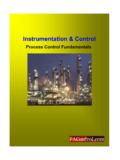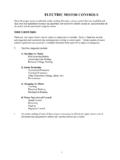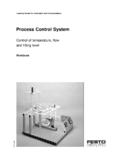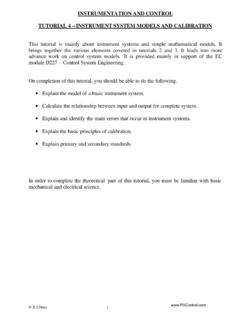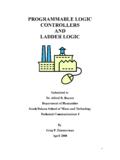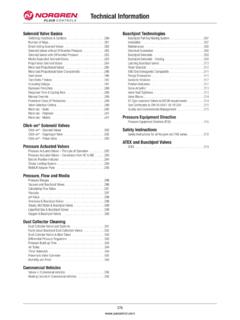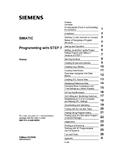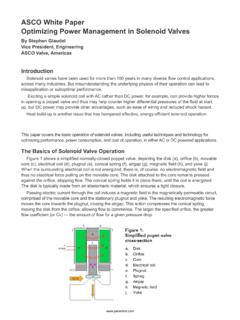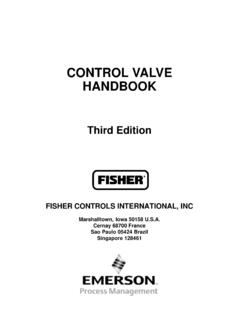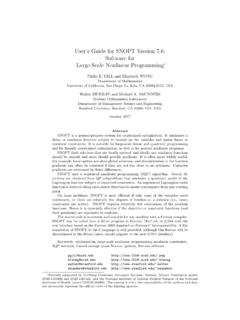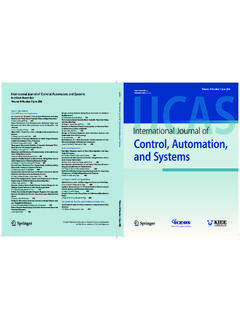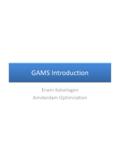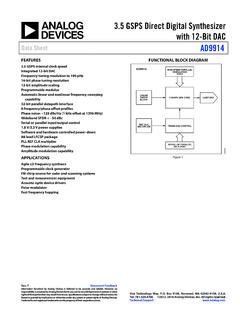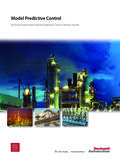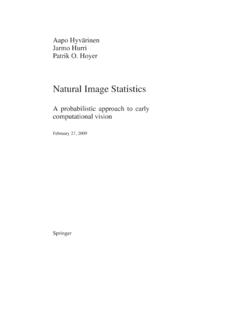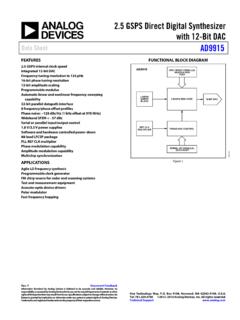Transcription of Design Of Fuzzy Controllers - Process Control and ...
1 Design Of Fuzzy ControllersJan Jantzen of a Fuzzy controller requires more Design decisions than usual, for exampleregarding rule base, inference engine, defuzzification, and data pre- and post tutorial paper identifies and describes the Design choices related to single-loop fuzzycontrol, based on an international standard which is underway. The paper contains also adesign approach, which uses a PID controller as a starting point. A Design engineer canview the paper as an introduction to Fuzzy controller ,QWURGXFWLRQ 6 WUXFWXUH RI D IX]]\ FRQWUROOHU 7 DEOH %DVHG &RQWUROOHU ,QSXW 2 XWSXW 0 DSSLQJ 7 DNDJL 6 XJHQR 7\SH &RQWUROOHU 6 XPPDU\ $ $GGLWLYH 5 XOH %DVH Technical University of Denmark, Department of Automation, Bldg 326, DK-2800 Lyngby, report no 98-E 864 ( Design )
2 , 19 Aug ,QWURGXFWLRQW hile it is relatively easy to Design a PID controller , the inclusion of Fuzzy rules createsmany extra Design problems, and although many introductory textbooks explain Fuzzy con-trol, there are few general guidelines for setting the parameters of a simple Fuzzy approach here is based on a three step Design procedure, that builds on PID Control :1. Start with a PID Insert an equivalent, linear Fuzzy Make it gradually related to the different components of the Fuzzy controller will be intro-duced shortly. In the next three sections three simple realisations of Fuzzy Controllers aredescribed: a table-based controller , an input-output mapping and a Takagi-Sugeno typecontroller.
3 A short section summarises the main Design choices in a simple Fuzzy controllerby introducing a check list. The terminology is based on an international standard which isunderway (IEC, 1996). Fuzzy Controllers are used to Control consumer products, such as washing machines,video cameras, and rice cookers, as well as industrial processes, such as cement kilns,underground trains, and robots. Fuzzy Control is a Control method based on Fuzzy as Fuzzy logic can be described simply as computing with words rather than numbers , Fuzzy Control can be described simply as Control with sentences rather than equations .A Fuzzy controller can include empirical rules, and that is especially useful in operatorcontrolled for instance a typical Fuzzy controller1.
4 If error is Neg and change in error is Neg then output is NB2. If error is Neg and change in error is Zero then output is NM(1) The collection of rules is called aUXOHEDVH. The rules are in the familiar if-then format, andformally the if-side is called theFRQGLWLRQand the then-side is called theFRQFOXVLRQ(moreoften, perhaps, the pair is calledDQWHFHGHQW-FRQVHTXHQWorSUHPLVH-FRQ FOXVLRQ). Theinput value Neg is aOLQJXLVWLFWHUP short for the word1 HJDWLYH the output value NB stands for1 HJDWLYH%LJand NM for1 HJDWLYH0 HGLXP. The computer is able to executethe rules and compute a Control signal depending on the measured objective here is to identify and explain the various Design choices for a rule based controller the Control strategy is stored in a more or less natural Control strategy is isolated in a rule base opposed to an equation based description.
5 Arule based controller is easy to understand and easy to maintain for a non-specialist equivalent controller could be implemented using conventional techniques in fact,any rule based controller could be emulated in, say,)RUWUDQ it is just that it is convenient2 DeviationsActionsOutputsRefControllerEnd -userInferenceengineRulebaseProcessFigur e 1: Direct isolate the Control strategy in a rule base for operator controlled Controllers are being used in various Control schemes (IEC, 1996). The mostobvious one isGLUHFWFRQWURO, where the Fuzzy controller is in the forward path in a feedbackcontrol system (Fig. 1). The Process output is compared with a reference, and if there isa deviation, the controller takes action according to the Control strategy.
6 In the figure, thearrows may be understood as hyper-arrows containing several signals at a time for multi-loop Control . The sub-components in the figure will be explained shortly. The controller ishere a Fuzzy controller , and it replaces a conventional controller , say, a3,'(proportional-integral-derivative) (Fig. 2) a measurable disturbance is being compensated. It re-quires a good model, but if a mathematical model is difficult or expensive to obtain, a fuzzymodel may be useful. Figure 2 shows a controller and the Fuzzy compensator, the processand the feedback loop are omitted for clarity. The scheme, disregarding the disturbance in-put, can be viewed as a collaboration of linear and nonlinear Control actions; the controllerC may be a linear PID controller , while the Fuzzy controller F is a supplementary nonlinearcontrollerFuzzy rules are also used to correct tuning parameters inSDUDPHWHUDGDSWLYHFRQWURO schemes (Fig.)
7 3). If a nonlinear plant changes operating point, it may be possible tochange the parameters of the controller according to each operating point. This is calledJDLQVFKHGXOLQJ since it was originally used to change Process gains. A gain schedulingcontroller contains a linear controller whose parameters are changed as a function of theoperating point in a preprogrammed way. It requires thorough knowledge of the plant, butit is often a good way to compensate for nonlinearities and parameter variations. Sensormeasurements are used asVFKHGXOLQJYDULDEOHV that govern the change of the controllerparameters, often by means of a table a Fuzzy Control Design will be stable is a somewhat open question.
8 Stabilityconcerns the system s ability to converge or stay close to an equilibrium. AVWDEOH linearsystem will converge to the equilibrium asymptotically no matter where the system statevariables start from. It is relatively straight forward to check for stability in linear systems,3++SumFFuzzy compensatorCControlleruDeviationDisturba nceFigure 2: Feedforward gain scheduleController parametersFigure 3: Fuzzy parameter adaptive example by checking that all eigenvalues are in the left half of the complex plane. Fornonlinear systems, and Fuzzy systems are most often nonlinear , the stability concept is morecomplex. A nonlinear system is said to beDV\PSWRWLFDOO\VWDEOHif, when it starts close toan equilibrium, it will converge to it.
9 Even if it just stays close to the equilibrium, withoutconverging to it, it is said to beVWDEOH(in the sense of Lyapunov). To check conditions forstability is much more difficult with nonlinear systems, partly because the system behav-iour is also inf luenced by the signalDPSOLWXGHV apart from theIUHTXHQFLHV. The literatureis somewhat theoretical and interested readers are referred to Driankov, Hellendoorn &Reinfrank (1993) or Passino & Yurkovich (1998). They report on four methods (Lyapunovfunctions, Popov, circle, and conicity), and they give several references to scientific is characteristic, however, that the methods give rather conservative results, which trans-late into unrealistically small magnitudes of the gain factors in order to guarantee possibility is to approximate the Fuzzy controller with a linear controller , andthen apply the conventional linear analysis and Design procedures on the approximation.
10 Itseems likely that the stability margins of the nonlinear system would be close in some senseto the stability margins of the linear approximation depending on how close the approxi-mation is. This paper shows how to build such a linear approximation, but the theoreticalbackground is still are at least four main sources for finding Control rules (Takagi & Sugeno in Lee,1990). ([SHUWH[SHULHQFHDQGFRQWUROHQJLQHHULQJNQR ZOHGJH One classical example is theoperator s handbook for a cement kiln (Holmblad & Ostergaard, 1982). The most com-mon approach to establishing such a collection of rules of thumb, is to question expertsor operators using a carefully organised questionnaire.)]]
